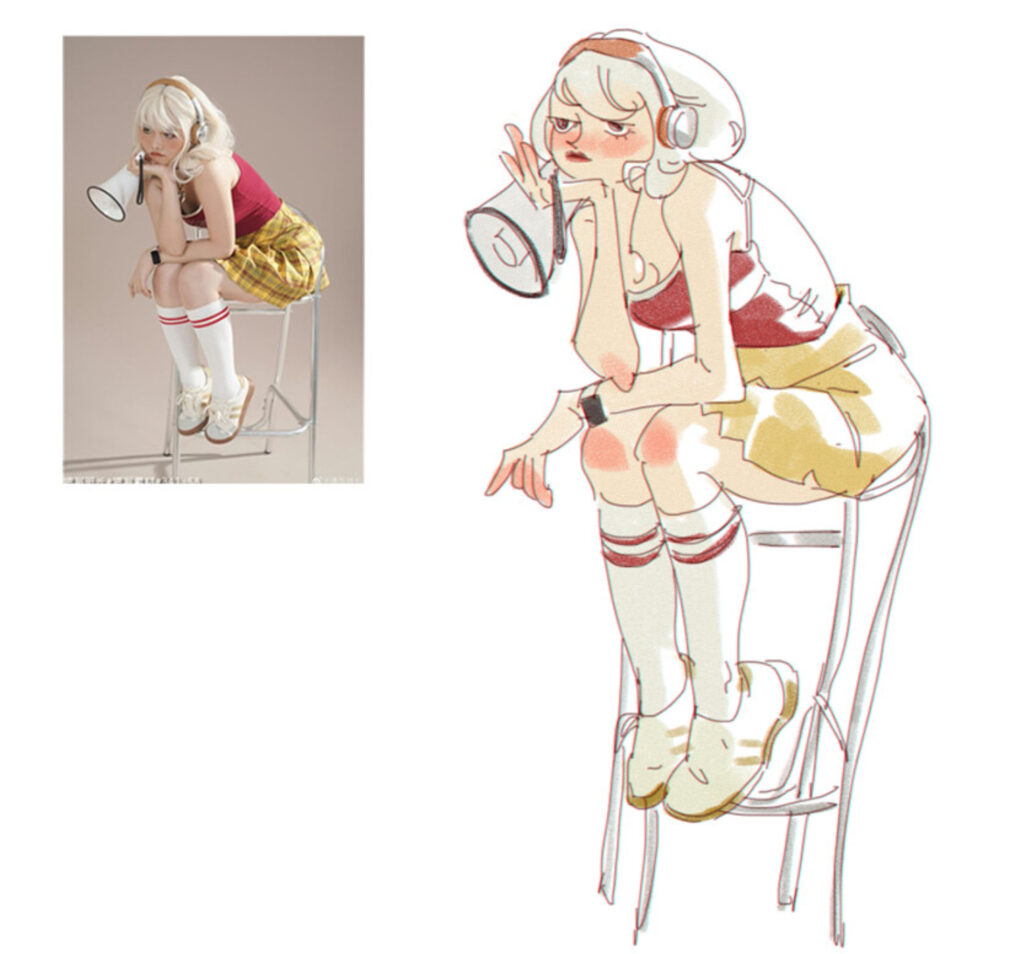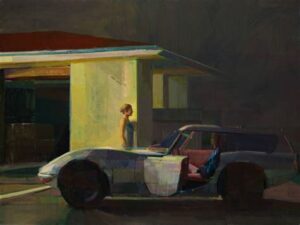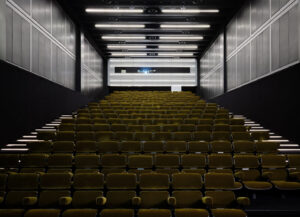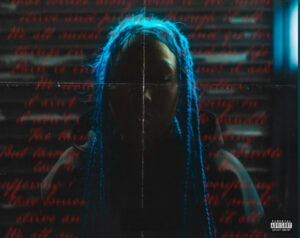In the shifting landscape of contemporary concept art, few voices resonate as powerfully and distinctively as Snowball Lam’s. A Shenzhen-based freelance concept artist, Lam has carved out a space defined by surreal vibrancy, cross-cultural hybridism, and an unmistakable sense of soul. Her work bridges the mundane and the fantastical, the historic and the speculative, the hand-drawn and the high-tech. Through characters, props, environments, and narrative scenes, she constructs entire visual worlds — breathing, emotionally charged spaces that pull the viewer into rich imagined realities.
Aesthetic DNA: Stylization with Substance
At first glance, Snowball Lam’s illustrations are instantly recognizable: bold yet delicate linework, saturated yet balanced color palettes, compositions that exude energy even in stillness. Her characters often come with exaggerated features — elongated limbs, oversized jackets, floating accessories — but never without grounding. There’s an internal logic to every distortion.
Lam doesn’t use stylization as a gimmick. Instead, she wields it to express essence. A hunched old man with a vast backpack isn’t just exaggerated for effect — he carries the weight of memory, of time, of a personal mythology only partially seen. Her cybernetic monks and dream-eating mechas aren’t just cool visual tricks; they feel like living archetypes from an unwritten legend. This careful merging of style and substance makes her work speak on multiple registers at once.
Characters That Feel Lived-In
Perhaps Lam’s most exceptional strength lies in character design. Her figures — whether they’re wandering scholars, rogue hackers, or celestial warriors — feel like they have pasts. They carry invisible biographies. Clothing choices hint at class or ritual. Scars, patches, and accessories tell stories with no words. Her characters look like they stepped out of a novel or game you haven’t played yet but instantly wish existed.
There is remarkable diversity in age, ethnicity, body type, and aesthetic subculture across her characters. Elderly women with cybernetic arms. Chubby boys with mystical scrolls. Women in mech armor sipping bubble tea. Lam resists the visual monotony that plagues much of modern digital art. Her people are not just beautiful — they’re interesting. They invite you to ask questions, to wonder where they’ve been and what they want.
Environments as Emotion
While many artists use environments as backdrop, Lam treats them as emotional agents. A quiet street at dusk rendered in vaporwave tones doesn’t just set the mood — it is the mood. Her cityscapes blur the line between nostalgia and futurism, between the real and the dreamed. Neon signs coexist with temple roofs. Dilapidated phone booths stand next to advanced transit drones. You see a world both falling apart and rebuilding itself in the same breath.
What sets Lam apart is how she instills personality into place. Whether it’s a room filled with talismans and tangled cables or an endless staircase beneath a mechanical sky, her environments feel like they’ve witnessed events, held secrets, suffered loss. There’s often a quiet melancholy in the corners of her compositions, a sense that the world she shows us is haunted by beauty and burden.
The Vaporwave of the East: Reclaiming Aesthetics
One of the most compelling aspects of Lam’s work is her appropriation and re-invention of vaporwave — that pastel-hued, glitch-heavy aesthetic born of internet nostalgia. But where many artists use vaporwave as kitsch or irony, Lam elevates it. She fuses it with East Asian visual culture: traditional scroll motifs, architecture, ceremonial garb. The result is a kind of visual remixing that reclaims aesthetics from global internet culture and repurposes them through a personal, regional lens.
In series like Neo Tokyo: Exponential Reality, she layers nostalgia not just for 1980s Japan, but for ancestral memory. The aesthetic becomes a language through which modernity and heritage speak. It’s not just retro-futurism — it’s rooted futurism.
Technological Fluency
Lam is a digital native in the truest sense. Her brushwork and texturing suggest deep comfort with a range of tools, from Photoshop to Procreate. Yet she avoids the trap of over-polish. Unlike the hyper-rendered sterility of much concept art, her pieces retain the tactile warmth of hand-drawn sketches.
She employs light with surgical precision — not just as illumination but as character. A glowing orb held by a shaman casts story-specific shadows. Neon reflections ripple across puddles in a rainy alley, suggesting unseen action. Lam understands that lighting in digital art is not decorative; it’s narrative.
Textures also play a crucial role. You can sense the grit of metal, the fray of fabric, the slickness of a plastic visor. Her surfaces have weight and wear. This isn’t digital painting as gloss — it’s digital painting as storytelling medium.
Storytelling Through Silence
Perhaps the most subtle — and haunting — feature of Lam’s work is her ability to tell stories without motion or dialogue. A character looking off-frame. A robot kneeling before a shrine. A girl floating above an empty playground. These are images heavy with implication.
Lam seems to reject the need for text or exposition. She trusts the viewer to assemble meaning from what’s shown — to listen to the silence between the strokes. This kind of narrative restraint is rare and powerful. It treats the audience not as consumers, but as co-creators of meaning.
Cultural Context and Global Reach
Though rooted in China, Lam’s work speaks globally. You’ll see influences from Japanese animation, European comics, and American sci-fi concept design — yet never in a derivative way. She metabolizes her influences into something new. A mech might carry Buddhist relics. A schoolgirl might wield a mystical fan. Nothing feels out of place because everything is filtered through her voice.
In a world where “Asian futurism” is often flattened into cliché, Lam brings nuance. She refuses to tokenize culture. Instead, she threads it into the very architecture of her visuals. You don’t just see Asian motifs — you see worldbuilding born from cultural logic, not aesthetic cherry-picking.
Audience Impact and Industry Significance
While Snowball Lam may not be a household name outside art circles, within the industry her influence is growing. Her work is regularly featured on platforms like ArtStation and Behance, where fellow artists praise her worldbuilding and emotional depth. She has contributed to game concepts, animated shorts, and speculative fiction, though much of her most impactful work remains personal.
This independence is a strength. It allows her to avoid the dilution that comes from commercial trend-chasing. Her art doesn’t cater to what’s popular; it sets its own terms. And increasingly, aspiring concept artists cite her as an influence — not just for style, but for voice. For the courage to be idiosyncratic in an industry that often rewards sameness.
Impression
In an era flooded with derivative digital art and content-first visual culture, Snowball Lam is something rare: an artist who remembers. She remembers the quiet wisdom of traditional design. She remembers the power of suggestion over spectacle. And perhaps most importantly, she remembers the future — not as something sleek and soulless, but as something fragile, layered, and human.
Her art invites us to imagine differently. To consider what the future might look like if it kept its elders close. If it let memory survive in metal. If it dared to be emotionally complex in its visions.
Snowball Lam doesn’t just illustrate. She renders — in every sense of the word. Worlds, emotions, histories, and futures. All compressed into frames that flicker like dreams you half-remember. And that, more than anything, is the mark of a true concept artist.
No comments yet.









